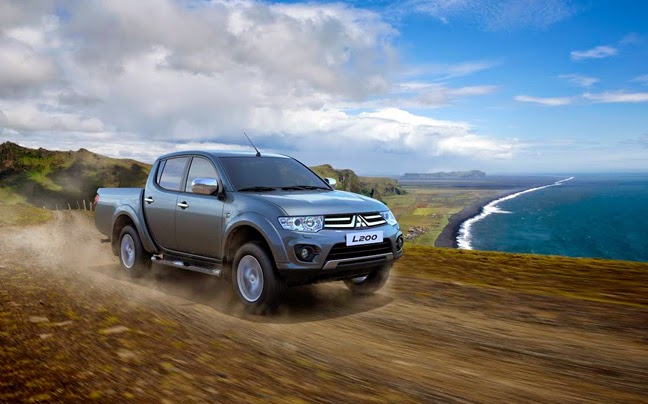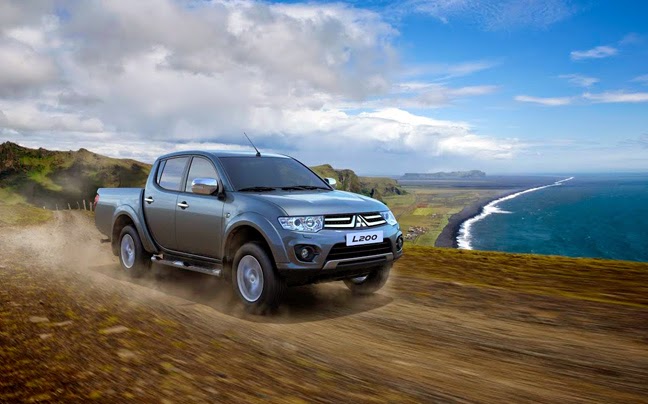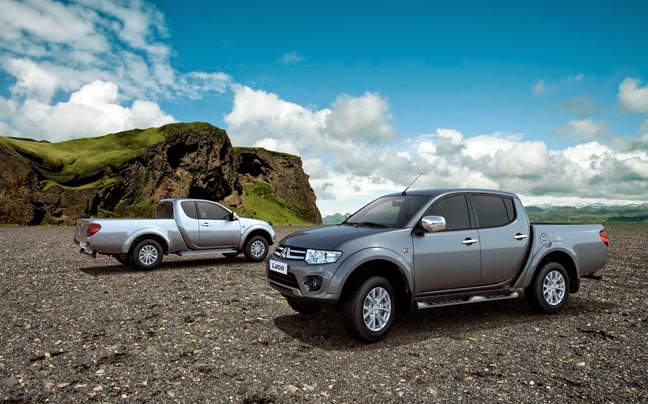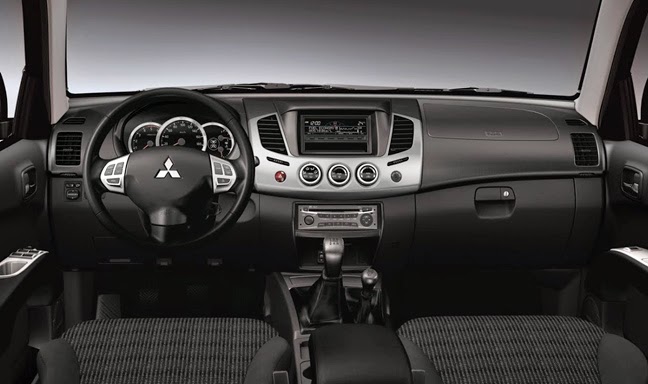The L200 has undergone a number of changes both externally and in the passenger compartment.
More specifically, the renewed L200 stands out from:
- The new mask for all versions Club & Double Cab.
Wider wheel eyebrows for Club Cab & Double Cab Intense Plus.
- Black interior in the passenger compartment.
- Active Stability Traction Control (ASTC) is now standard on all versions.
- Rich version of Double Cab 4WD Instyle.
The renewed L200 represents Mitsubishi's proposal for a modern European one-ton pickup, combining the purebred character of a professional car with the design, comfort and safety features of a modern SUV.
The L200, available in Single Cab, Club Cab and four-door Double Cab versions, continues the tradition established by the first L200 in 1978, as a vehicle of impeccable aesthetics and durability, suitable for work and leisure activities, in on-road conditions & off-road.
Sport Utility
Whether used for work and / or leisure activities, as a genuine business tool (ACT - Active Commercial Truck = Single Cab) or as a dual-use vehicle (ART = Active Recreational Truck = Club Cab and Double Cab), the new L200 has designed to compete head-to-head with the (traditionally) most comfortable and best-equipped SUVs.
The key features of the L200 are:
- Spacious cabin with top interior length 215,3 cm (Double Cab),
- "Super Select" four-wheel drive system, unique in the pick-up category,
- Active stability and traction control systems - ASTC, unique in the pick-up category,
- Top turning circle 5.9 m in the category,
- Diesel engine complying with Euro-4 specifications,
- 4-star passive insurance at Euro-NCAP,
- Choice of 3 body types: single cab (single cab), club cab and 4-door double cab,
- Passenger car environment and comfort for rear passengers (back angle adjustment, cup holders integrated in the central armrest, etc.,…) with unique features (electrically open rear windshield, etc.…).
Active and passive security
Keeping in mind the European driving conditions and habits, MMC engineers have given priority to safety over other factors in order to meet the requirements of local customers.
Active safety: To prevent accidents.
Passive safety: To reduce the potential consequences of an accident.
Avoidance
Precise directionality, low center of gravity, traction & stability, strong brakes and good acceleration when overtaking: Everything determines the kind of dynamic behavior required in Europe.
Super Select all-wheel drive system »
Mitsubishi Super Select system allows the driver to select the most suitable setting in the four-wheel drive gearbox, according to the terrain and driving conditions. It can be changed from 2WD to 4WD "on the go", ie without stopping the car (possible below 100 km / h), regardless of the type of road.
The advantage of Super Select is in the position of permanent four-wheel drive "4H" Full Time that can be used at any speed and on any surface. In the special case of a pickup like the L200, the Super Select gives significant traction when the car is driven with an empty body, as is very often the case with a SUT.
In this 4H program, the central cohesive coupling differential perfectly distributes the driving power between the front and rear axles.
In addition to the "Super Select" all-wheel drive system, the "Easy Select" system is also available (depending on the market and model), which can also be changed from 2WD to 4WD without stopping the car (possible below 100 km / h) , regardless of the type of road, as is the case with "Super Select").
Appreciating the real off-road needs more than the appearance, the engineers have preferred a practical four-wheel drive selector, instead of the rotary switch made fashionable by the competition.
Finally, the L200 equipped with the Easy Select and Super Select all-wheel drive system enjoys the advantages of an electronically controlled rear differential lock system. By pressing a switch on the dashboard, both rear wheels are fully locked (possible below 12 km / h) for maximum traction on loose ground. The reliability of the system is guaranteed both in rivers and in icy weather conditions, due to the structure of the internal baffle used to lock the rear differential.
Active Stability (ASC) + Active Traction Control (ATC) = ASTC in standard equipment.
Unique in the category of pick-ups and promoted by the largest European safety organizations as a mechanism that can significantly reduce the risk of accident for any car equipped with it, the stability control system is adopted for the first time in pickup by Mitsubishi. Here, a traction control system is added, resulting in a single ASTC (Active Stability & Traction Control) system which belongs to the standard equipment of all versions.
As part of the general electronics architecture of the new L200, the ASTC is based on a steering angle sensor as well as a G acceleration and rotation sensor, in addition to the original ABS (wheel speed & brake fluid pressure) sensors. Together with the engine ECU, the A / T ECU and the ASC ECU, they all communicate with each other via a bus (BUS).
In addition to the optional four-wheel drive system, active safety is increased by the ASTC system:
- Controls the behavior of the vehicle in emergencies.
- Controls oversteer and understeer on wet roads.
- Warns the driver.
- The system can be switched off via an on-board switch for off-road driving.
Suspension, steering and brakes
The redesign process applied to the L200 also had extensions to the suspension, steering and brakes, in order to achieve the driving behavior of an SUV.
- Front suspension with double wishbones and spiral springs, for improved stability on uneven terrain, stability (even in abrupt braking), rigidity, maintenance and weight saving (12kg).
- The rear axle is placed under the springs, to improve comfort, distance from the road on uneven terrain, stability (due to reduced body slopes), improved balance of road behavior empty / loaded, as well as higher strength and lower tilt driving.
- Hanger due to the inherent properties of a hanger system but also higher rigidity than the previous one.
Additional benefits include reduced response and sifting of the steering wheel, lower vibration and noise levels, weight savings (13 kg) and easier maintenance.
Last but not least, this steering wheel gives the L200 a 5.9 m turning cycle.
DOHC 2.5 Common-Rail Turbo-Diesel Direct Injection Engine
The L200 engine, in addition to the power it provides, also contributes to active safety, thanks to its high torque and low fuel consumption engine:
L200 178 HP L200 136 HP
Maximum power 178 ps @ 3.750 rpm 136 ps @ 4,000 rpm
Maximum torque 400 Nm @ 2,000 rpm 314 Nm @ 2,000 rpm
Weight / power ratio 10.11 kg / ch 13.7 kg / ch
0 - 100 km / h 12.1. 14.6
Final speed ** 179 km / h 167 km / h
CO2 (combined cycle) 225 204 g / km
Καταν. fuel (mixed cycle) 7.8 l 7.8 l
Passive Security
A patent from Mitsubishi for all its new products, the "Reinforced Impact Safety Evolution" (RISE) system plays an important role, integrating and interconnecting building blocks for active occupant protection in the event of an accident.
In addition, the L200 offers:
- Airbags for driver and front passenger.
- Deactivation switch for the front passenger airbag.
ISO-FIX child seat attachment bases.
- Preloaders & load limiters for driver and front passenger seat belts.
- Front end (hood) designed for optimized pedestrian protection.
- New seat design structure (better protection against rear impact, jolt and frontal impact).
- Careful design of the rear roof section (at the rear windshield assembly) to avoid injuries.
- Safety function (trap protection) for all electric windows, electric sunroof and rear opening electric windshield.
- Side impact beams on the doors.
- Retractable pedal structure, to reduce injury to the driver's lower limbs at the time of the collision.
- Steering column that recedes in two stages.
- Fuel tank mounted in front of the rear axle.
- Square cross-section frame with front deformation elements, for better damping of impact energy.
Together with the RISE structure, these measures contribute to the L200 earning a 4-star rating in EURO-NCAP (internal testing).
Interior design
The interior of the L200 respects the design philosophy of the exterior, departing from the box design commonly used in pickups.
Designed with the needs of the driver in mind, the dashboard remains true to the spirit of the pickup, adopting durable and easy to clean materials, which have undergone an innovative.
Most design details aim to make life in the car special, from the attractive shape of the steering wheel to the blue overlapping instruments with the chrome frames, the ring that frames the gear and four-wheel drive selectors or the modern blue A / C controls
Light helps to create a special environment. At night, light sources located throughout the cabin create a relaxing atmosphere, while improving ergonomics. During the day, the cabin is "airy", thanks to the low line of windows, and a large, strongly sloping windshield.
This huge crystal surface, placed away from the dashboard to free up a lot of space in front of the driver and front passenger, is also a pleasant change from the compression cabs we usually find in pickups, offering a more relaxed car-like driving position. with very small front section (cab forward).



